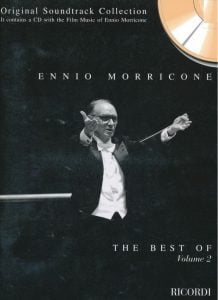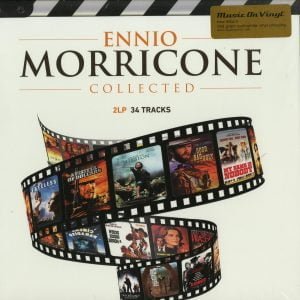Browse in the Library:
Or browse in the categories menus & download the Library Catalog PDF:
Ennio Morricone– The Good, the Bad and the Ugly (Piano solo arr. & sheet music)
Ennio Morricone

Morricone was born in Rome in 1928 into a musical family. His father, a trumpeter, had built a solid reputation in music circles as a performer, whether it be jazz, opera or film music.
At the age of six, Ennio Morricone devoted himself to music and at seven he was already studying composition; at ten, he enrolled in the Santa Cecilia Conservatory, graduating in 1956. During his formative years, Morricone showed little interest in film music, but his professional calling was awakened in 1954, after attending the screening of The Rabe, written by Alfred Newman.
In 1959, he received his first full score assignment when director Luciano Salce asked him to write the music for the film Il Federale (The Federal Soldier). Over the next couple of years, Morricone scored a dozen films, including Duello nel Texas (Shootout at Red Sands) in 1963, his first Western, and Malamondo, in 1964, which brought international attention to the talent of him in the making.
Morricone has composed the soundtrack for more than 500 movies and television series. He is the winner of an Oscar for best soundtrack in 2016 for The Hateful Eight and an honorary Oscar awarded in 2006.
Morricone’s compositions have been part of more than 20 award-winning films, as well as symphonic and choral pieces. Among others, his works in spaghetti western films stand out, with the help of his friend Sergio Leone, such as For a Fistful of Dollars, Death had a price, The Good, the Bad and the Ugly or Until his time came.
However, his work extends to many genres of composition, thus making him one of the most versatile composers in the history of cinema and also one of the most influential of the 20th century. His compositions for Days of Heaven, The Mission or Cinema Paradiso have been cataloged as authentic masterpieces.

Browse in the Library:
Or browse in the categories menus & download the Library Catalog PDF:
Best Sheet Music download from our Library.
The Good, the Bad and the Ugly
The good, the bad, the ugly (Il buono, il brutto, il cattivo) is a German-Spanish-Italian film directed by Sergio Leone and released in 1966. Within the most famous westerns is the history of cinema, if you consider the epitome of the ‘spaghetti western’ style.
To wrap up his Dollar Trilogy (also known as the Man with No Name Trilogy) and to avoid repeating himself, Sergio Leone is increasing the number of protagonists from two to three: Clint Eastwood and Lee Van Cleef, who co-starred in And for a Few Dollars more, add Eli Wallach in this third film.
The scenario introduces another novelty: the irruption of History, with the Civil War as a backdrop. For so much, chronologically it is a step back compared to the other two films in the trilogy, i.e. a prequel.
Of the mystical way, the character of ‘the man with no name’, played by Clint Eastwood (the constant that unites the three films), does not appear in his usual outfit: he is wearing a lot of dust from the covering of type, and is only in At the end of the film if he places a poncho, then adopting the external appearance of the character from the first two films and materializing, according to Leone’s idea, the cyclical aspect of the trilogy.
Following the success of A Fistful of Dollars and And for a Few Dollars More, United Artists executives contacted the screenwriter of both films, Luciano Vincenzoni, to acquire the rights to his earlier works and to his upcoming Westerns. Neither he, nor producer Alberto Grimaldi, nor Sergio Leone had any plans in mind.
In fact, Leone wasn’t even planning on making another western. However, lured by the huge sum of money offered (which would allow her to be financially independent for the rest of his life), he accepted the proposal, without even thinking of the next film. Fortunately for him, Vincenzoni came up with the idea of a ‘film about three scoundrels in search of treasure during the Civil War’. ‘
The studio agreed, and the project was allocated a budget of US$1 million (plus 50% of proceeds from ticket sales outside of Italy). In the end, the film will cost 1.3 million, an astronomical sum considering the precarious conditions in which Leone had had to work just two years earlier.
The original title of the film was The Two Magnificent Bons-à-rien, but it was changed from the start of shooting, when Vincenzoni imagined the title The Good, the Bad and the Ugly ( Il buono, il brutto, il cattivo ), which immediately Leone liked.
